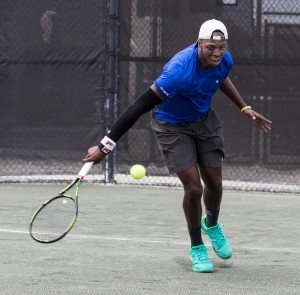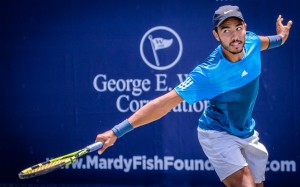By Jean-Luc Fontanot
“I have a dream…” was the start of one of history’s most important speeches. But, many tennis players also have a dream: the dream to be at the top of the ATP ranking, holding the coveted grail.
And what an amazing sight – for us to have the chance to see this group of champions fighting for their dream. It hits home with everyone that has had a dream and touches our sense of determination, our will to win and our motivation to be the best.
Tennis is an “elite” sport that is sustained by everyone who is not elite. Without this wide base of players from all over the world, we would not have the sport we love so much. These players are what make up the social part of tennis, the part where we can actually see champions being made. While this social aspect is extremely important in the development of tennis on every level and in every country, it takes a backseat to the actual competition…and the development of competition. Herein, lies the beauty of our sport.
Several years ago, players wanted more. More prize money, more tournaments, more… that is. And as a coach, I had to agree. Prize money has to be shared amongst the professional players. But who is professional? Most of them have been “professional” since age 12 or 13 and the commitment, dedication, effort and money they have put into tennis to get to a top spot is truly unmatched. I say yes. They deserve it.
But, are you really a professional at 12? What does it really take to become professional? I believe that a professional player starts when you play with the bigger guys. When you start to play Challenger Tournaments.
Some players do not have the courage to play Challenger Tournaments because they are scared to drop their ranking by losing too early in the qualifying round but having the courage to try – and keep trying — is the only way to achieve your goal. True, some good players are left on the sideline by having to play too many tournaments, wasting money and get lost in the ranking instead of going for BIG. But, my solution for this is simple: Take the shorter way for the one who can but also to let the others the chance to play and to win.
And when players complain about prize money, I really want to say that we play a sport to play the game. If you become good at the sport, you make money at the game if you make the right decisions. We don’t play Futures for the money but for the points and the development. Let’s just try to save money and to spend on the right topics. And if you don’t make money, you play the sport because of your passion for the game. The strong, elite players – like the ones we have today – do not just put on a good show but instill the desire to play tennis in many others. I think it is natural for them to make what they make. And I tell my players…”maybe one day it will be your turn.”
The women, however, have it even more difficult. They certainly play with the same passion as the men but make even less money. They have to be factored into the solution as well.
Until 2006, players could play satellite tournaments. Satellite tournaments were a set of three tournaments and a masters. The goal of these tournaments was to gain points and qualify for a masters and then convert them to ATP points. But, the real goal was to jumpstart tennis – to jumpstart that base of players I mentioned. And it worked. Players without points were still able to play qualifying matches. But, it was a heavy-handed attempt at a solution to build the base. Later, the idea was to host Futures Tournaments ($10K, $15k, $15K+H*) and the ATP had ($25K, $25K+H*, 50K, 50K+H* and so on…until $125K+H*). At this point, the number of players travelling for tournaments was about 20% to 30% of what it is now.
Until the beginning of 2016, the ITF was offering prize money in the Futures Tournaments between $10k and $15k but after complaints from many players, the ITF decided to raise the prize money to start at $15k.
Now, many tournaments were being cancelled because they simply could not generate this amount of money. So, the goal of these Futures Tournaments – to develop players and completion and for the players to gain points to play in Challenger Tournaments – failed because of called-off tournaments and the players’ lack of faith in the system. This new system goes against development. Too many players with a decent ranking will try to stay in the futures, making a living and not having the courage and responsibilities to play challengers and higher will keep on playing futures taking the spot of unranked players. Do you think it’s normal to see Futures tournaments requiring 2 ATP points to enter?
The ITF and ATP are two very different institutions. with two different goals. To develop tennis – and take care of professional tennis players – the way we should, these two organizations need to work hand-in-hand.
While a long-standing solution will take time, there are several things we can work on to make the sport better. Now.
1- Return to the previous prize money structure to avoid the clubs’ struggles to raise such large amounts and keep the dynamic of the clubs that want to host tournaments; the ITF has to realize that some countries have economic issues such as inflation or currency exchange that affect their ability to come up with big payouts.
2- Offer better playing conditions complete with chair umpires from the qualies, ball changes and new practice balls; having chair umpires starting in the qualifying round (following the French example to develop the formation of young umpires) creates an energy of professionalism and competition amongst the players. And a sense of pride.
3- Offer points based on a base prize money ($5k, $10k or $15k) but offer it within the hospitality (none, half, full, transportation, etc.) to decrease the money spent by the players and also to reward the local businesses that work with the club to organize the tournaments. This will allow players to afford to play in more tournaments.
4- Offer more prize money and ATP points in the Challenger tournaments – both qualifying rounds and main draw — to force players with good ranking to play and to keep the spirit of the Futures Tournaments: development.
5- Have the ATP and ITF assist the clubs in raising the prize money for the tournaments, not for the clubs to make money but to help the players financially.
6- In some countries, like the USA, players need to win five matches to win one ATP point. But, winning five matches is basically winning a tournament. This is a tough challenge at best without chair umpires and balls being used for two sets. Players end up qualifying but being exhausted when they start the main draw. Why not offer a bonus point to the players who qualify and win four rounds?
So, what does a player really want?
To win, of course. but to get there, you need to sacrifice a lot, make smart choices along the way and be part of the solution and not the problem. And, of course, you have to have a dream…
*1H: Hospitality



